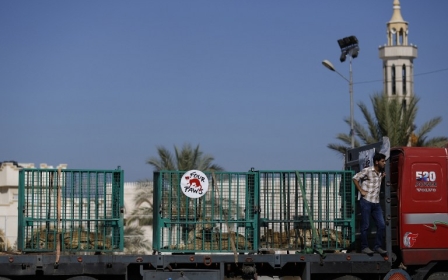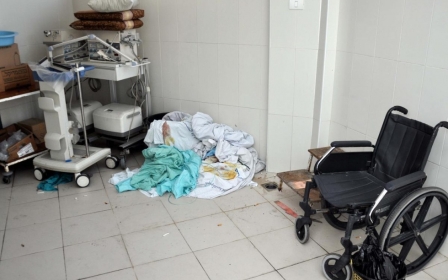Not so sweet potatoes: uncertainty over Gaza’s exports after war

This week, 30 tonnes of sweet potatoes were exported to the EU from Gaza for the first time since the beginning of the Israeli invasion on 8 July.
Tahseen Al-Saqqa, the director general of marketing at the Palestinian Ministry of Agriculture in Gaza, said that the Strip will now start exporting goods to outside markets, especially to Europe. But there is no indication of how many exports Israel will actually allow.
Palestinian farmers have received promises that Israel will allow the export of flowers, spices and vegetables - all of which are crucial to allow Gaza’s economy to recover - although the announcement about easing the sweet potato export freeze will only provide marginal relief.
Saqallah says Gaza has 12,000 dunums (1,200 hectares) planted with sweet potatoes, which is only a small amount of the total Gazan agriculture that was damaged in Israel’s 51-day war. The Ministry of Agriculture in Gaza estimates damages sustained by the agricultural sector because of the Israeli invasion at around $550m.
Nor is that whole 1,200 hectares viable. A sweet potato farmer, interviewed previously by MEE, complained that only one out of 10 potatoes was fit for export to Europe, as the majority of his crop had been damaged by shrapnel from the war, rendering it unfit for European markets.
Gaza-based economist Maher al-Taba’a, told MEE that Israel allowing sweet potatoes “is nothing more than media propaganda which is meant to confuse international audiences by showing that the situation of Gaza crossings is better after the ceasefire agreement.”
Al-Taba’a, who is in charge of public affairs at the chamber of commerce, said the facts on the ground show a different reality than that seen in the international media.
“The records I have on the ground show that Israeli crossings are much worse than they were before the war started,” he said.
After the ceasefire, “the number of trucks crossing between 27 August- 26 September were only 5,031. When we compare this to the same period in 2013, we see there were 5,169 trucks crossing,” he added.
Token amounts
Prior to the imposition of Israel’s blockade in 2008, Gaza was well known for some of its exports. Its world-famous carnations were a regular sight in Amsterdam flower markets; while its cherry tomatoes, basil and other herbs would make it to shops and supermarkets all over Europe and America.
Al-Taba’a explains that the vast majority of Gazan people think there is absolutely no change at the crossings and that only a token amount of things are coming in or out.
He insisted that Gaza’s farmers and other private sector producers and traders had high hopes that a truce, at the very least, would allow goods from Gaza to begin flowing to fellow Palestinians in the West Bank, but even this most basic relaxation has not occurred, and it takes an hour and a half just to get the products out of Gaza.
“If Israel is serious and wants to end the siege on Gaza, and improve the Gaza economy, it would have allowed Gazans to market both industrial and agricultural products in West Bank markets,” said al-Taba’a.
“After all, there are no security pretexts which could be used for not allowing Gaza products to get to West Bank markets.”
Gaza’s unemployment rate - fuelled by years of Israeli restrictions - now stands at a crippling 55 percent, a 10 percent increase from just before the war.
Workers who used to be employed in Israel and those in the construction sector have been the hardest hit but the crisis has impacted all segments of the economy.
“Allowing Gaza to export to West Bank will improve the economic flow and decrease the unemployment rate by 7-10 percent,” said al-Taba’a.
But this does not seem to be coming anytime soon, despite the fact that Gaza’s population is growing fast.
Gaza’s population has risen from 1.4 million in 2007 to more than 1.8 million today, and is forecast to grow to 2.13 million by the end of the decade.
“Yet today the average number of trucks that comes into Gaza is 163 trucks per day - while prior to 2007, when Gaza’s population was 1.4 million, Israel allowed 700 trucks,” said al-Taba’a. He explained that under current population levels Gaza should be getting at least 1,000 trucks a day, including 400 trucks of construction materials.
According to Mohammed Ghaban, a 50-year-old Gazan farmer, allowing sweet potato exports is simply not enough, and he, and many other farmers like him, desperately need to start exporting to the West Bank and further afield.
Last week, a few Palestinian merchants and heads of Gaza’s agricultural organisations met with Israeli military officials at Erez crossing.
According to officials who attended the meet, the Israelis promised that they would soon allow Gaza’s fishermen to export fish to the land-locked West Bank, but even this relaxation has been greeted with scepticism.
“How come they want us to export fish when Gaza does not have enough fish given the limited fishing zone of six nautical miles?” said Ghaban. “After all, we rely on importing frozen fish from abroad to cover the needs here in Gaza.”
Ghaban explained that most farmers in Gaza would prefer to export to the West Bank rather than to European markets, as transportation and storage costs often ate into profits and there was always the risk of produce spoiling on its way to market.
“We want reliable crossings,” Ghaban said. “We have European clients who relied on us to export and if we are not allowed to export, then the clients start to exclude us in future co-operation.”
“If Israel want to expand export, it should allow essential pesticide materials to produce vegetables and fruits,” Ghaban added.
While most of these materials are on Israel’s banned list, some other items which were initially banned in 2007, have gradually been taken off the list. Shoelaces, ketchup and candles were all considered contraband at one point, with Palestinians and aid agencies continually urging Israel to further reduce its prohibition list.
Middle East Eye propose une couverture et une analyse indépendantes et incomparables du Moyen-Orient, de l’Afrique du Nord et d’autres régions du monde. Pour en savoir plus sur la reprise de ce contenu et les frais qui s’appliquent, veuillez remplir ce formulaire [en anglais]. Pour en savoir plus sur MEE, cliquez ici [en anglais].




